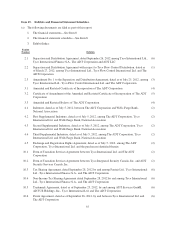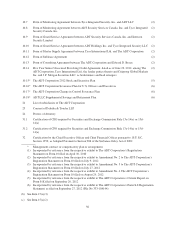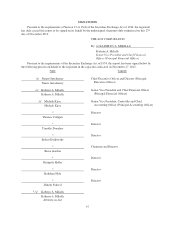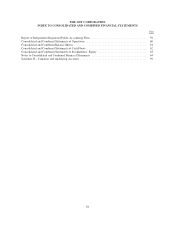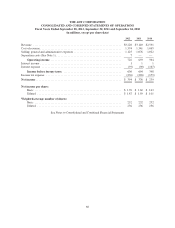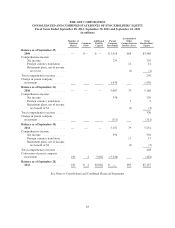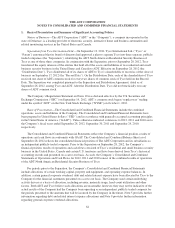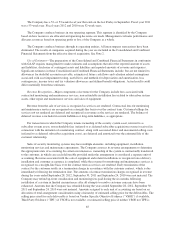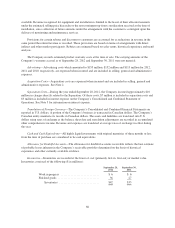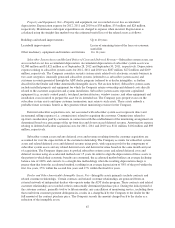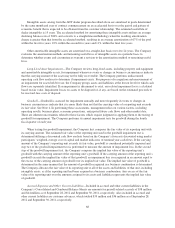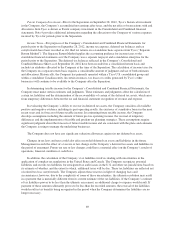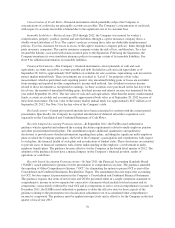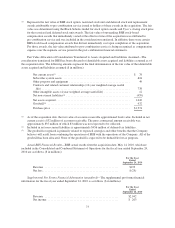ADT 2012 Annual Report Download - page 157
Download and view the complete annual report
Please find page 157 of the 2012 ADT annual report below. You can navigate through the pages in the report by either clicking on the pages listed below, or by using the keyword search tool below to find specific information within the annual report.The Company has a 52- or 53-week fiscal year that ends on the last Friday in September. Fiscal year 2011
was a 53-week year. Fiscal years 2012 and 2010 were 52-week years.
The Company conducts business in one operating segment. This segment is identified by the Company
based on how resources are allocated and operating decisions are made. Management evaluates performance and
allocates resources based on operating profit or loss of the Company as a whole.
The Company conducts business through its operating entities. All intercompany transactions have been
eliminated. The results of companies acquired during the year are included in the Consolidated and Combined
Financial Statements from the effective date of acquisition. See Note 2.
Use of Estimates—The preparation of the Consolidated and Combined Financial Statements in conformity
with GAAP requires management to make estimates and assumptions that affect the reported amount of assets
and liabilities, disclosure of contingent assets and liabilities and reported amounts of revenue and expenses.
Significant estimates in these Consolidated and Combined Financial Statements include, but are not limited to,
allowances for doubtful accounts receivable, estimates of future cash flows and valuation related assumptions
associated with asset impairment testing, useful lives and methods for depreciation and amortization, loss
contingencies, income taxes and tax valuation allowances and defined benefit obligations. Actual results could
differ materially from these estimates.
Revenue Recognition—Major components of revenue for the Company include fees associated with
contractual monitoring and maintenance services, non-refundable installation fees related to subscriber system
assets, other repair and maintenance services and sales of equipment.
Revenue from the sale of services is recognized as services are rendered. Contractual fees for monitoring
and maintenance services are recognized on a straight-line basis over the contract term. Customer billings for
services not yet rendered are deferred and recognized as revenue as the services are rendered. The balance of
deferred revenue is included in current liabilities or long-term liabilities, as appropriate.
For transactions in which the Company retains ownership of the security system asset, referred to as
subscriber system assets, non-refundable fees (referred to as deferred subscriber acquisition revenue) received in
connection with the initiation of a monitoring contract, along with associated direct and incremental selling costs
(referred to as deferred subscriber acquisition costs), are deferred and amortized over the estimated life of the
customer relationship.
Sales of security monitoring systems may have multiple elements, including equipment, installation,
monitoring services and maintenance agreements. The Company assesses its revenue arrangements to determine
the appropriate units of accounting. In certain circumstances, ownership of the system is contractually transferred
to the customer, in which case each deliverable provided under the arrangement is considered a separate unit of
accounting. Revenue associated with the sale of equipment and related installations is recognized once delivery,
installation and customer acceptance is completed, while the revenue for monitoring and maintenance services is
recognized on a straight-line basis over the contract term as services are rendered. Early termination of the
contract by the customer results in a termination charge in accordance with the customer contract, which is due
immediately following the termination date. The amounts of contract termination charges recognized in revenue
during the years ended September 28, 2012, September 30, 2011 and September 24, 2010 were not material. The
Company may refund up-front consideration and monitoring fees paid during the six months following
installation of a system in limited circumstances after all attempts to resolve customer concerns have been
exhausted. Amounts that the Company has refunded during the years ended September 28, 2012, September 30,
2011 and September 24, 2010 were not material. Amounts assigned to each unit of accounting are based on an
allocation of total arrangement consideration using a hierarchy of estimated selling price for the deliverables. The
selling price used for each deliverable is based on Vendor Specific Objective Evidence (“VSOE”) if available,
Third Party Evidence (“TPE”) if VSOE is not available, or estimated selling price if neither VSOE nor TPE is
65


